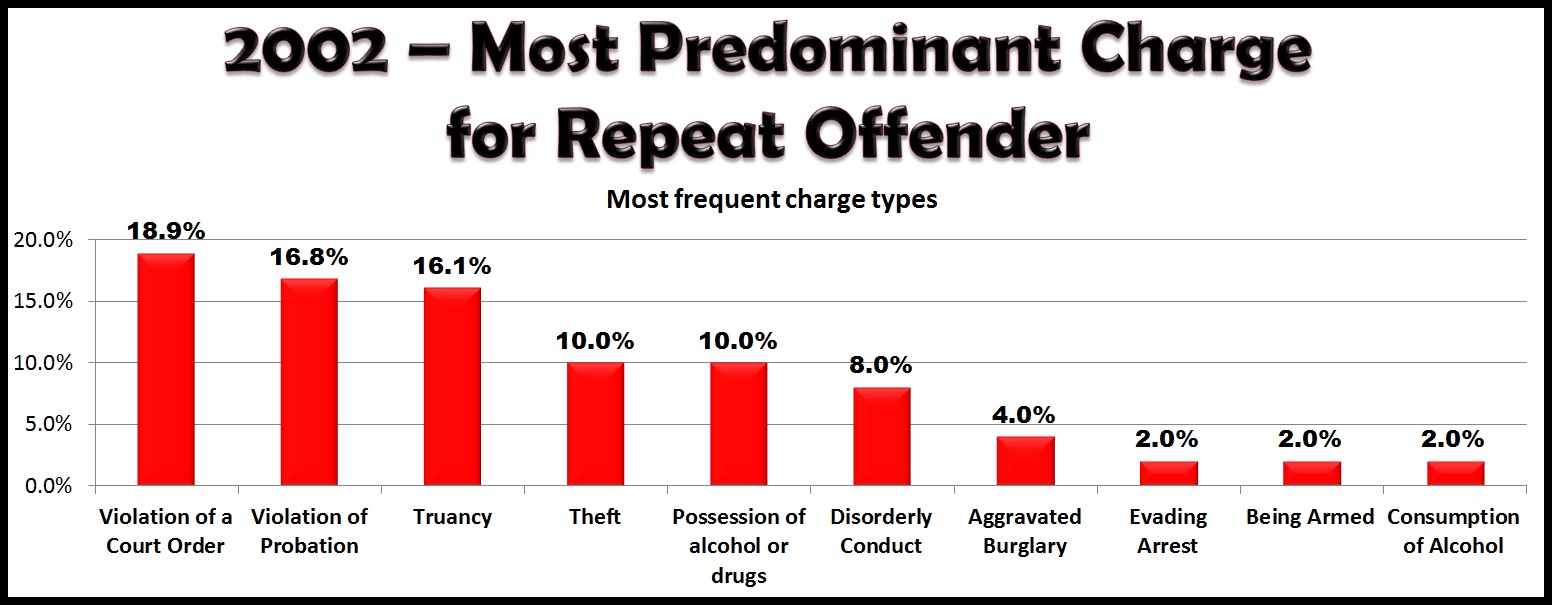 Report in Brief
Report in Brief
February 10, 2004
EXECUTIVE SUMMARY
This report in brief presents summary information on the ![]() (
(![]() ) program in northeast Tennessee. Specifically, data for all juveniles enrolled in the
) program in northeast Tennessee. Specifically, data for all juveniles enrolled in the ![]() program in 8 counties were examined to determine whether a new charge, of any kind, was filed in the past year.
program in 8 counties were examined to determine whether a new charge, of any kind, was filed in the past year.
METHODOLOGY
Courtroom personnel in the 8 counties gathered data for this report. Ms. Kristin Peterson collected the data from the courtroom personnel and then entered the data in raw form into a spreadsheet program. Ms. Peterson was hired via subcontractor agreement with the First Tennessee Human Resources Agency (FTHRA) in Johnson City, TN. The data was then cleaned and analyzed by Dr. David Holleran; Dr. Holleran also entered into a subcontractor agreement with the FTHRA.
The overall sample of ![]() data in the master data file consisted of 761 cases. Because the individual charge was the unit of analysis, some
data in the master data file consisted of 761 cases. Because the individual charge was the unit of analysis, some ![]() participants may be listed more than once in the database. The new charge results are first presented with the individual charge as the unit of analysis (i.e., charge). The new charge results (county-level only) are then presented with the individual participant as the unit of analysis (i.e., participant).
participants may be listed more than once in the database. The new charge results are first presented with the individual charge as the unit of analysis (i.e., charge). The new charge results (county-level only) are then presented with the individual participant as the unit of analysis (i.e., participant).
OVERALL RESULTS (charge)
The majority (i.e., 72%) of the ![]() program participants did not have a new charge during 2002; thus, the
program participants did not have a new charge during 2002; thus, the ![]() program has successfully intervened in the lives of troubled youth.
program has successfully intervened in the lives of troubled youth.
The minority (i.e., 18%) of ![]() program participants that did have a new charge in 2002 had three charge types that were predominant: Violation of a Court Order, Violation of Probation, and Truancy respectively.
program participants that did have a new charge in 2002 had three charge types that were predominant: Violation of a Court Order, Violation of Probation, and Truancy respectively.
- Most frequent charge types (descending order):
- Violation of a Court Order (18.9%)
- Violation of Probation (16.8%)
- Truancy (16.1%)
The three charge types comprised slightly more than half (i.e., 52%) of the new charges among the ![]() participants. The remaining charge types were diverse. Theft comprised nearly 10 percent of the new charges. Possession of alcohol or drugs was also nearly 10 percent of the new charges. Disorderly conduct comprised 8 percent of the new charges. The remaining charges included aggravated burglary (4%), evading arrest (2%), being armed (2%), and consumption of alcohol (2%).
participants. The remaining charge types were diverse. Theft comprised nearly 10 percent of the new charges. Possession of alcohol or drugs was also nearly 10 percent of the new charges. Disorderly conduct comprised 8 percent of the new charges. The remaining charges included aggravated burglary (4%), evading arrest (2%), being armed (2%), and consumption of alcohol (2%).

COUNTY-LEVEL RESULTS (charge)
The ![]() data was collected for 2002 from 8 cities and counties in northeast Tennessee: Bristol, Church Hill, Greene, Hawkins, Johnson City, Sullivan, Washington, and Unicoi.
data was collected for 2002 from 8 cities and counties in northeast Tennessee: Bristol, Church Hill, Greene, Hawkins, Johnson City, Sullivan, Washington, and Unicoi.
Cities and Counties with no new charge reported:
- Bristol
- Church Hill
- Unicoi
Bristol, Church Hill, and Unicoi County ![]() program participants had no new charges reported for the year. This perhaps points to programmatic success in the implementation of
program participants had no new charges reported for the year. This perhaps points to programmatic success in the implementation of ![]() in these locales.
in these locales.
The participants from the 5 remaining counties had at least one new charge reported. The results remain promising, however.
Success percentages for cities and counties with at least one new charge (descending order) reported:
- Greene (87.9%)
- Johnson City (80.0%)
- Washington (79.1%)
- Hawkins (76.8%)
- Sullivan (76.7%)
Greene County had the highest success percentage (i.e., 88%) among cities and counties with at least one new charge reported. Johnson City, Washington County, Hawkins County, and Sullivan County all demonstrated a promising success percentage despite having participants with at least one new charge. Overall, more than three-fourths of the ![]() participants in these counties had no new charges reported.
participants in these counties had no new charges reported.
COUNTY-LEVEL RESULTS (participant)
As noted, the database contained multiple entries for any single ![]() participant if the participant had more than one charge; hence, the unit of analysis in this instance is the individual charge. Since the
participant if the participant had more than one charge; hence, the unit of analysis in this instance is the individual charge. Since the ![]() program is geared to reach individuals, it is important to also present results where the individual is the unit of analysis. A separate database was constructed whereby each individual was listed only once regardless of the new charge type.
program is geared to reach individuals, it is important to also present results where the individual is the unit of analysis. A separate database was constructed whereby each individual was listed only once regardless of the new charge type.
The database consisted of 538 cases.
Success percentages for cities and counties with at least one new charge (descending order) reported:
- Johnson City (92.3%)
- Greene (89.7%)
- Washington (88.8%)
- Hawkins (84.8%)
- Sullivan (83.7%)
The success of the ![]() program becomes even more apparent when the data is analyzed with the individual as the unit of analysis.
program becomes even more apparent when the data is analyzed with the individual as the unit of analysis.
Johnson City had slightly more than 90 percent (i.e., 92.3%) of its ![]() participants with no new charges. Greene County and Washington County had approximately 90 percent of their
participants with no new charges. Greene County and Washington County had approximately 90 percent of their ![]() participants with no new charges. In all, the 5 counties with at least one new charge among its
participants with no new charges. In all, the 5 counties with at least one new charge among its ![]() participants had better than an 80 percent success rate to report.
participants had better than an 80 percent success rate to report.
CONCLUSION
The results of this report indicate that the ![]() program successfully intervenes in the lives of troubled youth. While there is a slight degree of heterogeneity in county-level programmatic success (i.e., some counties reported no new charges), the results from the 8 counties overall indicate that the
program successfully intervenes in the lives of troubled youth. While there is a slight degree of heterogeneity in county-level programmatic success (i.e., some counties reported no new charges), the results from the 8 counties overall indicate that the ![]() program is homogeneous in its promise for troubled youth.
program is homogeneous in its promise for troubled youth.
Please direct all correspondence concerning this report to:
David Holleran, Ph.D
Box 70555
East Tennessee State University
Johnson City, TN 37614









